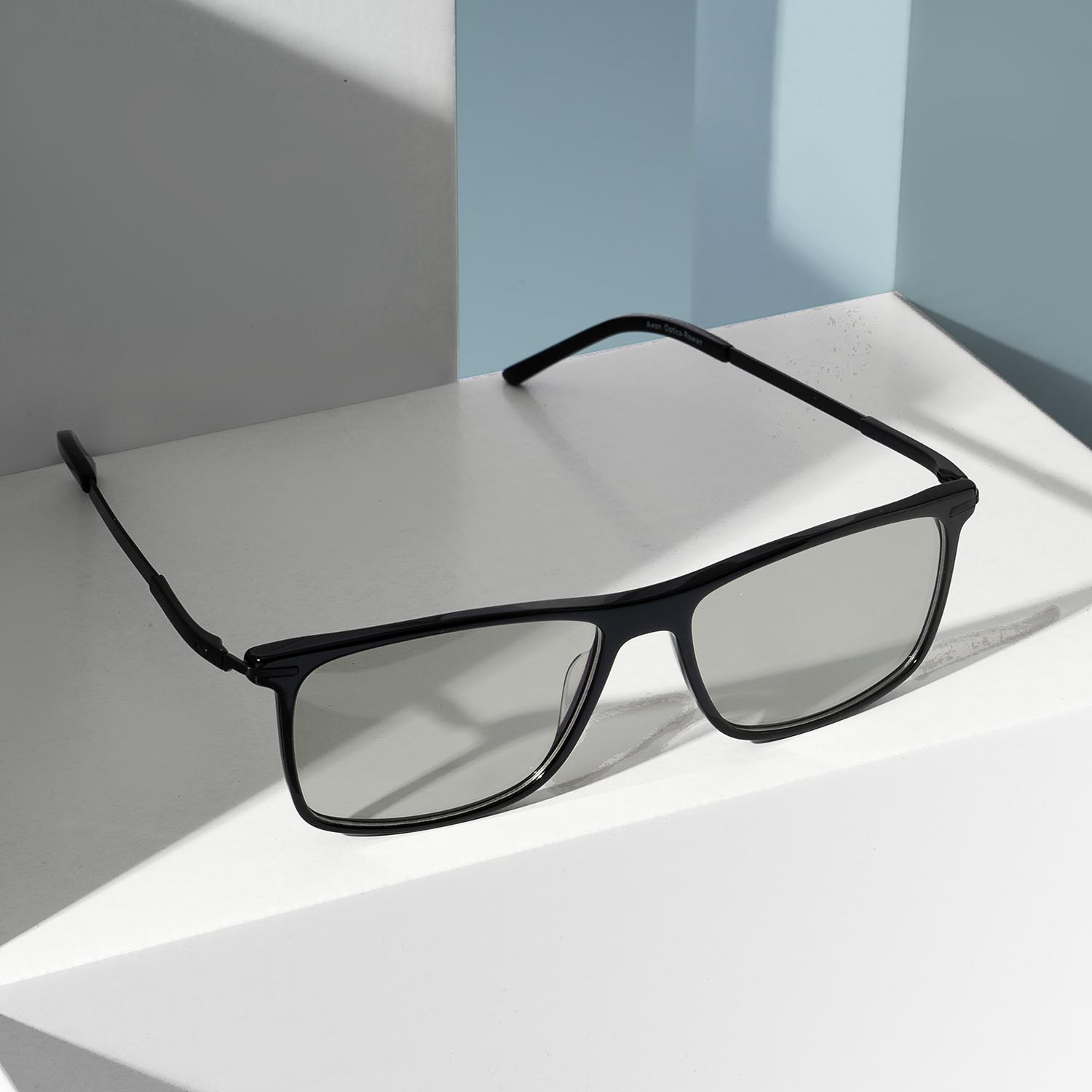
Axon Optics vs Blue Light Blocking Glasses
Blue light blocking glasses are made under many names – Blutech, Migraine Shields, Aspectus, Gunnar Optics, or a host of others.
The problem with blue light blocking glasses is that they all vary significantly in blocking certain light – but they are all consistent in one thing: they don’t block the types of light shown to aggravate light sensitivity and migraine.
By contrast, Axon Optics glasses powered by Avulux® Migraine & Light Sensitivity Lenses are made specifically for those with photosensitive symptoms such as migraine.
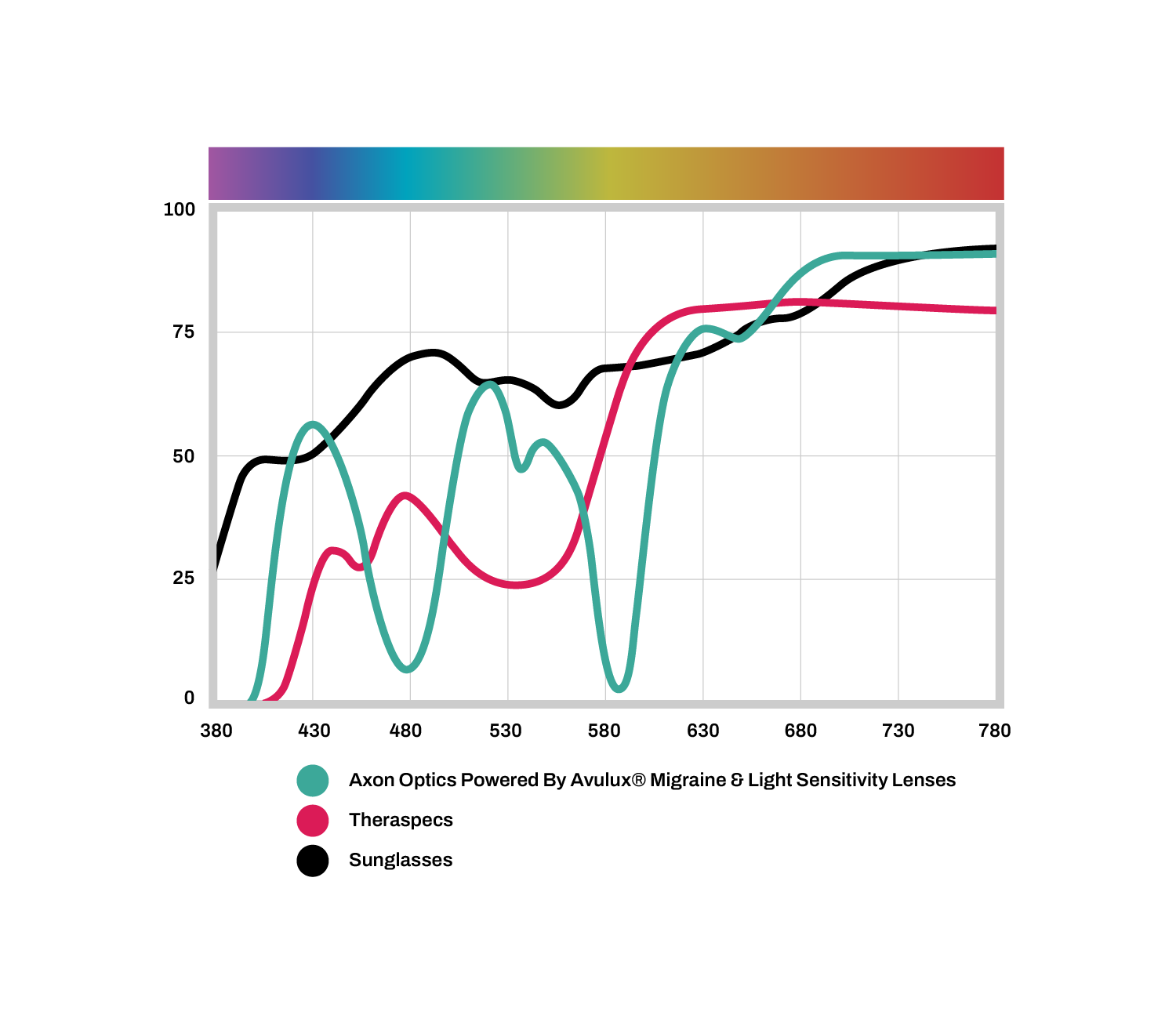
Axon Optics Reduce The Negative Impact Of Light — Blue Blockers Don’t
Despite numerous studies, there is a lack of consistent evidence for the efficacy of blue-blocking glasses. ¹
However, Axon Optics powered by Avulux® Migraine & Light Sensitivity Lenses are engineered specifically to absorb blue, amber and red wavelengths of light while letting in soothing green light. Wearing Axon Optics, as part of a healthy lifestyle, may help those living with migraine and light sensitivity.
Compare
Despite Their Name, Many Blue Light Glasses Don’t Block Much Blue Light
You'll notice from the chart that blue blockers also don't block a lot of blue (480nm) or amber light (590nm). Both blue and amber light are shown to aggravate photosensitivity.³ For the most effective light management, you want to block both.
Fortunately, Axon Optics lenses reduce over 80% of the blue light and up to 97% of the amber light reaching your eyes.
Blue Light Blocked
Amber Light Blocked
85%
97%
5%
5%
15%
5%
30%
5%
20%
5%
People Love Their Axon Optics Glasses Powered By Avulux® Migraine & Light Sensitivity Lenses
Georgina D.
Super Helpful For Chronic Migraine
So happy I invested in these glasses. They have been super helpful on my rough days with chronic migraines and photophobia and help prevent flares. Thank you!
transition pair for her job as she also suffers from migraines. ”
Bolivar E.
Excellent quality and excellent light sensitivity protection
Highly recommended, light weight, cool design and excellent light sensitivity protection, my eyes feel relieved
Kat C.
Amazing glasses!
I never take mine off! People always ask me where they're from as if they're just for fashion. Avulux is my new go-to eyeware. I have chronic migraine and I won't say they're the "be all end all cure," but they certainly assist my WFH life. I wear them to night events, dinners, when on screens and everything in between 10/10.

Do Blue Light Blocking Glasses Work?
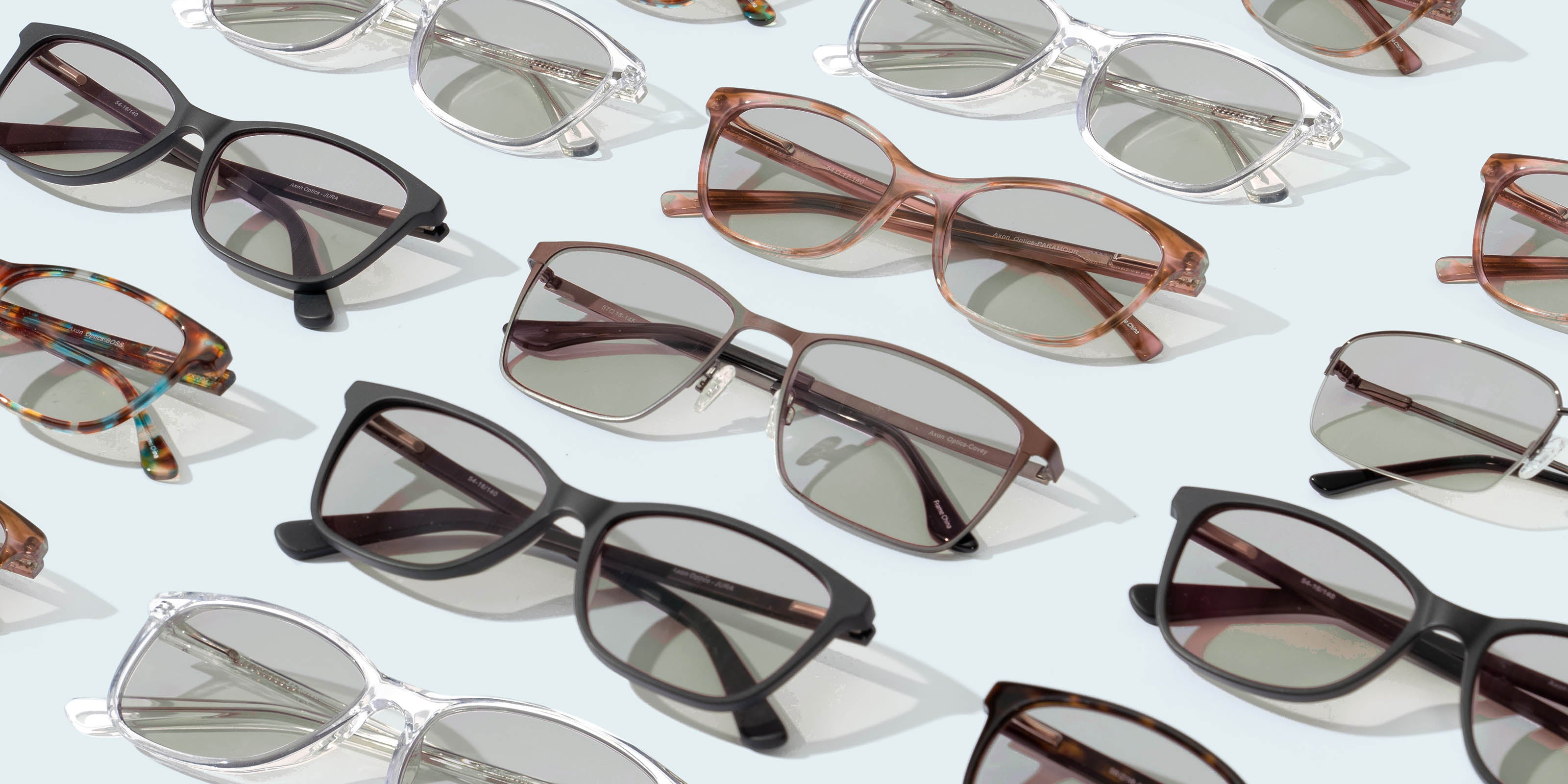
Avulux® Migraine & Light Sensitivity Lenses Are Consistent In Quality
With blue light blockers, you never know what you are getting. Along with their many names, blue blockers vary widely in the type of light they block.⁴ Unless you have a spectrometer to measure them, it's tough to know what they're actually filtering.
At Axon Optics, we frequently use a spectrometer to measure competing lenses. As you'll see below, blue blocker lenses come in a lot of different colors, which means they block different types of light. By comparison, every pair of Axon Optics lenses has the same tint because they block the same types of light — the types science tells us make you uncomfortable.
Avulux® Migraine & Light Sensitivity Lenses Reflect Less Harmful Glare Into Your Eyes
Don't you hate it when fluorescent light reflects off your glasses into your eyes? Many blue light blocking lenses don't include any anti-reflective coatings. Combine this with the fact that they could be blocking too much good light, and the resulting glare could aggravate your light sensitivity.
Lucky for you, prescription or custom Axon Optics glasses powered by Avulux@ Migraine & Light Sensitivity Lenses can be purchased with advanced anti-reflective coatings so you won't be increasing your risk of harmful glare.
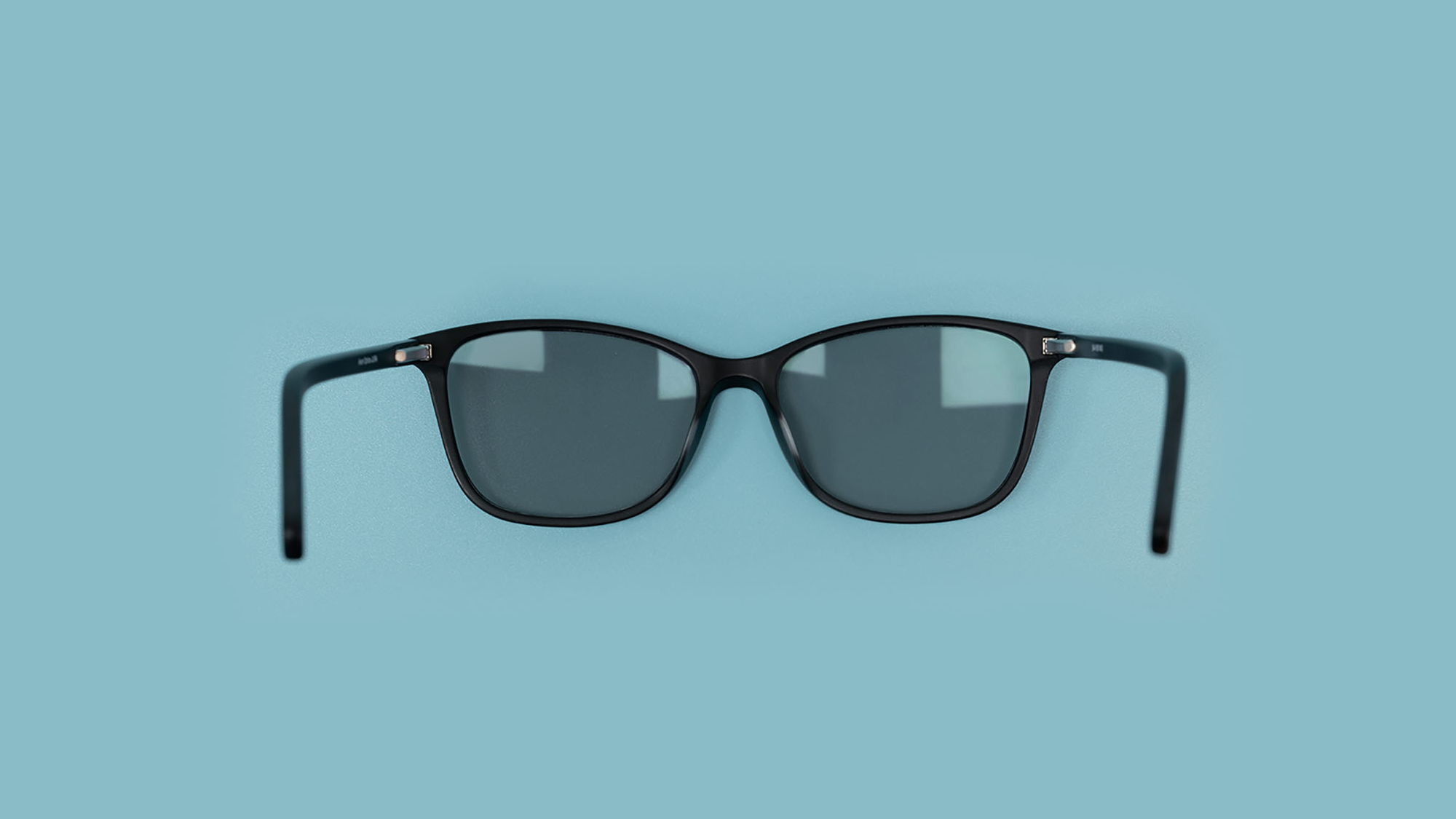
Before

After

Axon Optics Frames Are High Quality
Many blue blocker frames are just cheap “gas station” frames. Axon
Optics will never sell these. We’re obsessed with providing you sturdy, comfortable, and lightweight frames that match the quality of our lenses.
Oh, and they look great on you, too!
Axon Optics Is The Original And Most Innovative Lens Manufacturer
The Axon difference lies in our science, our ongoing research, and our ties to the medical community.

Founding Scientific Team
Axon was co-founded by Dr. Bradley Katz, a neuro-ophthalmologist and photosensitivity scientist at the world-renowned Moran Eye Center at the University of Utah Hospital, with Dr. Steve Blair, a photonics researcher at the University of Utah.

Ongoing Research
Our founders have published many academic articles on light sensitivity and migraine.⁵ Dr. Katz has treated thousands of photosensitive patients.
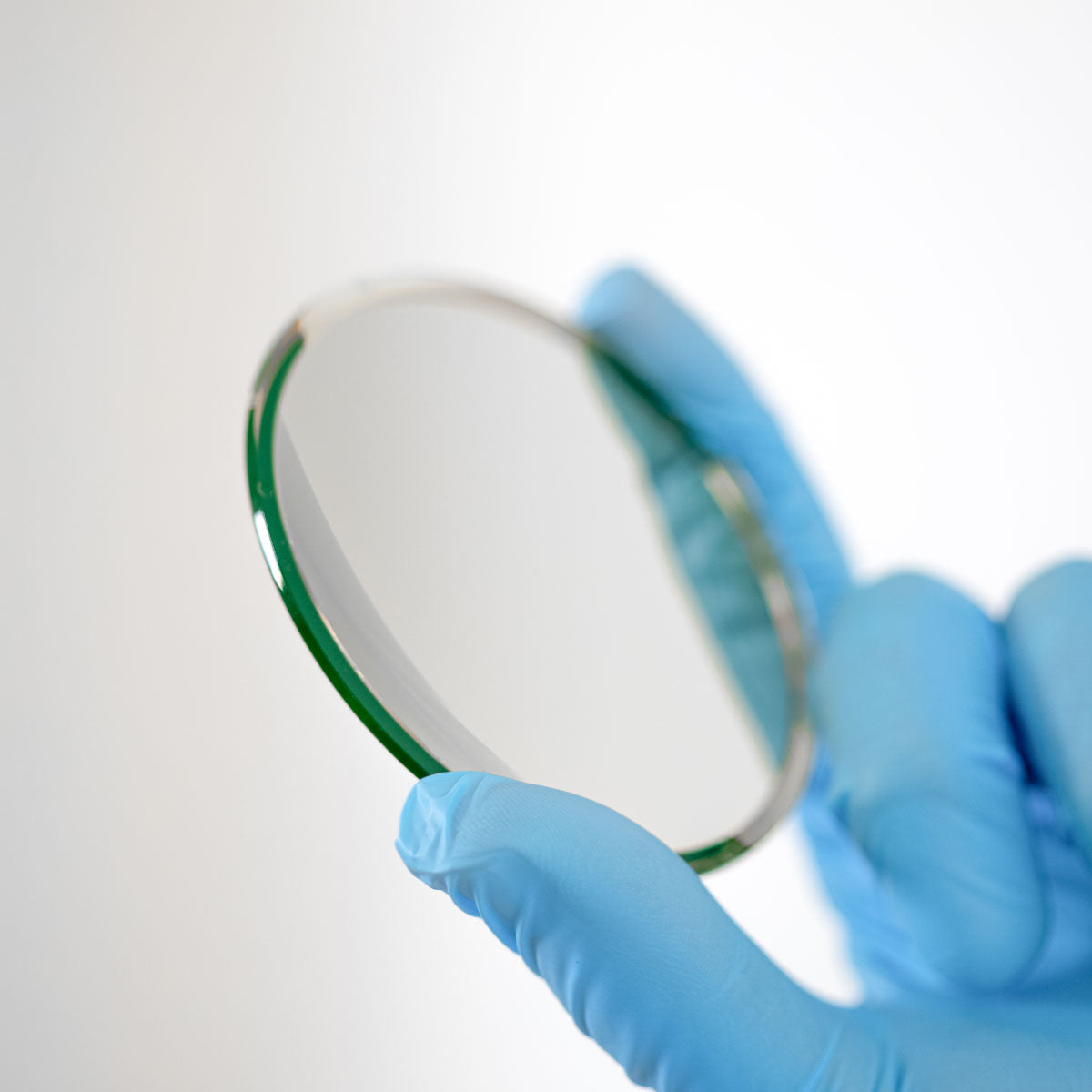
Origination
In 2011, Axon Optics pioneered the idea of perfecting eyewear for migraine and photosensitivity and has continued to improve its lens over the past decade. The continuing research and guidance of our expert founders helps us continue to refine our lenses. We do everything we do to improve the lives of people with light sensitivity and migraine.
Your comfort is the most important thing.
Lens Spectrum Comparison
Y axis – light transmission | X axis – light wavelength
If the line is lower on the graph, it means less light coming through.

Axon Optics
Axon Optics Glasses Powered By Avulux® Migraine & Light Sensitivity Lenses reduce the blue and amber wavelengths shown to trigger and worsen migraine attacks.
Green light has been shown to be soothing to migraineurs.
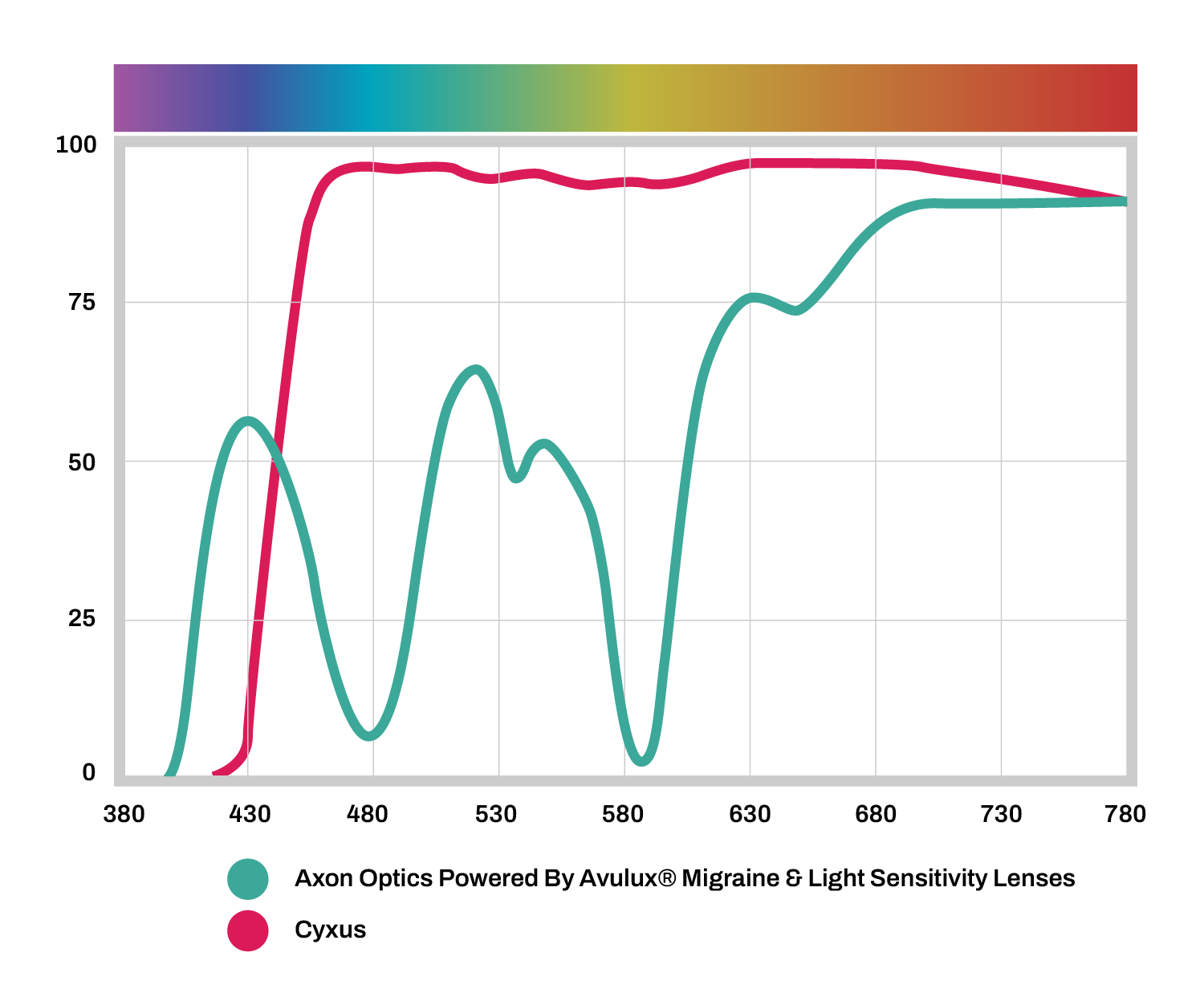
Cyxus
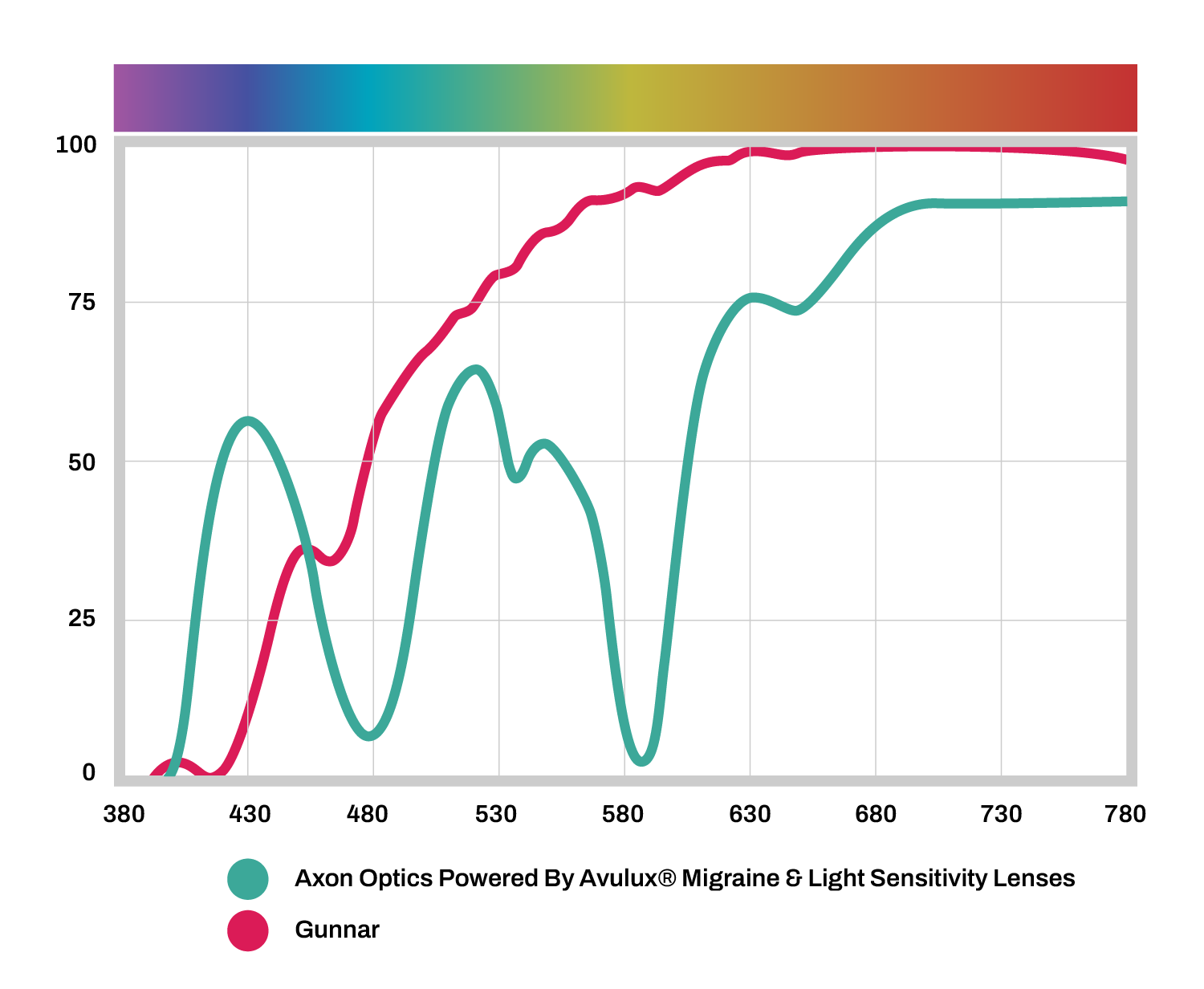
Gunnar
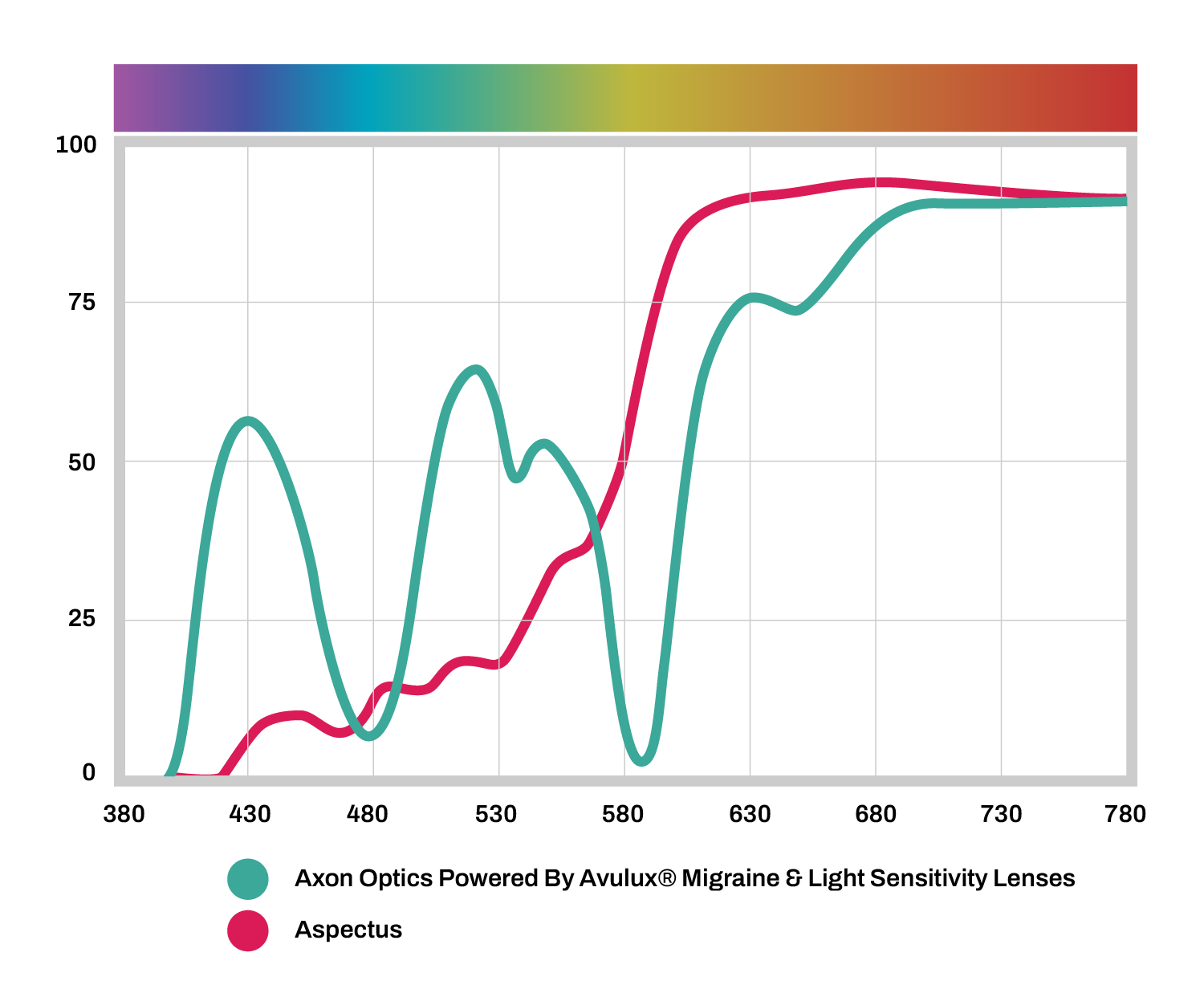
Aspectus
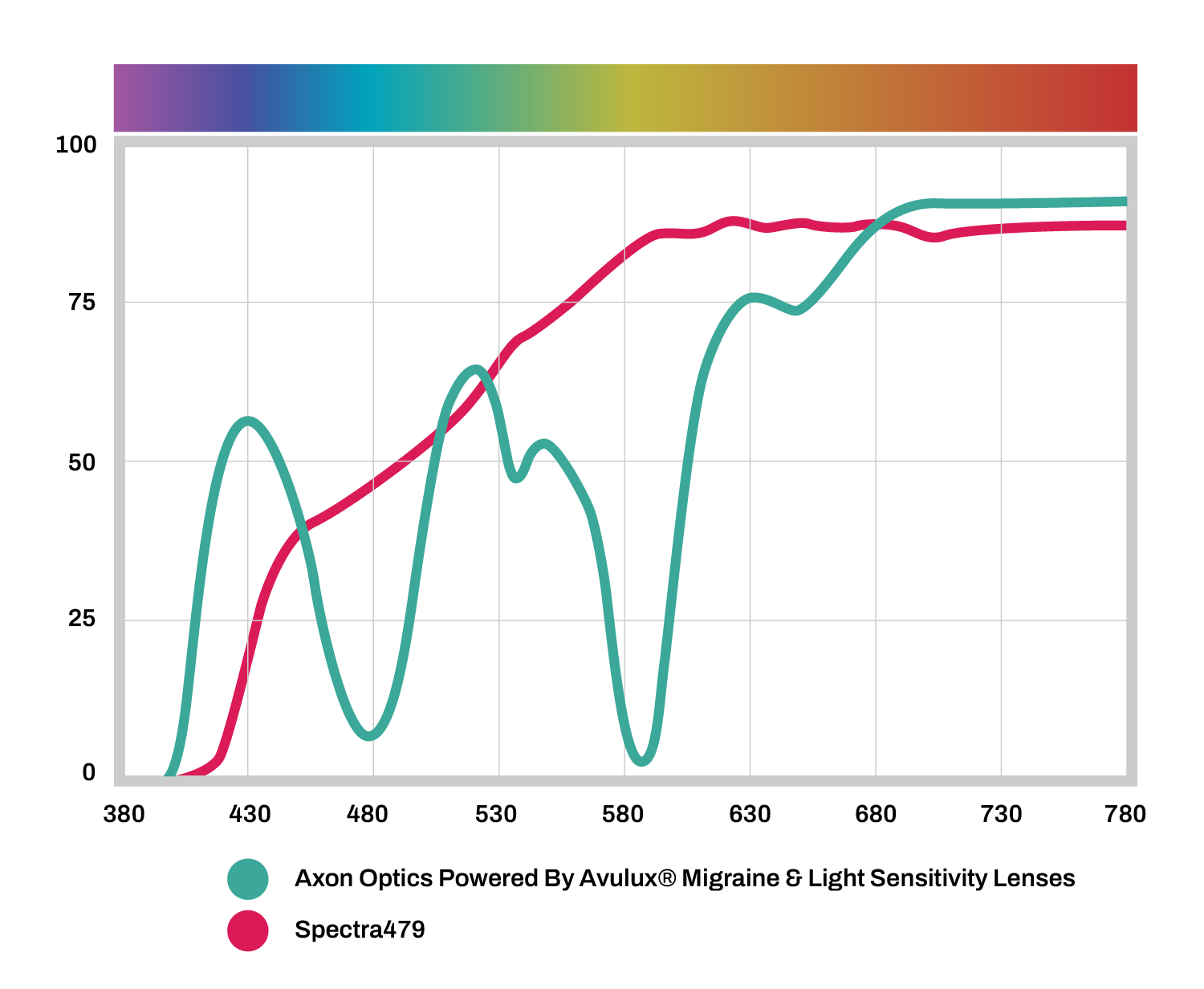
Spectra479
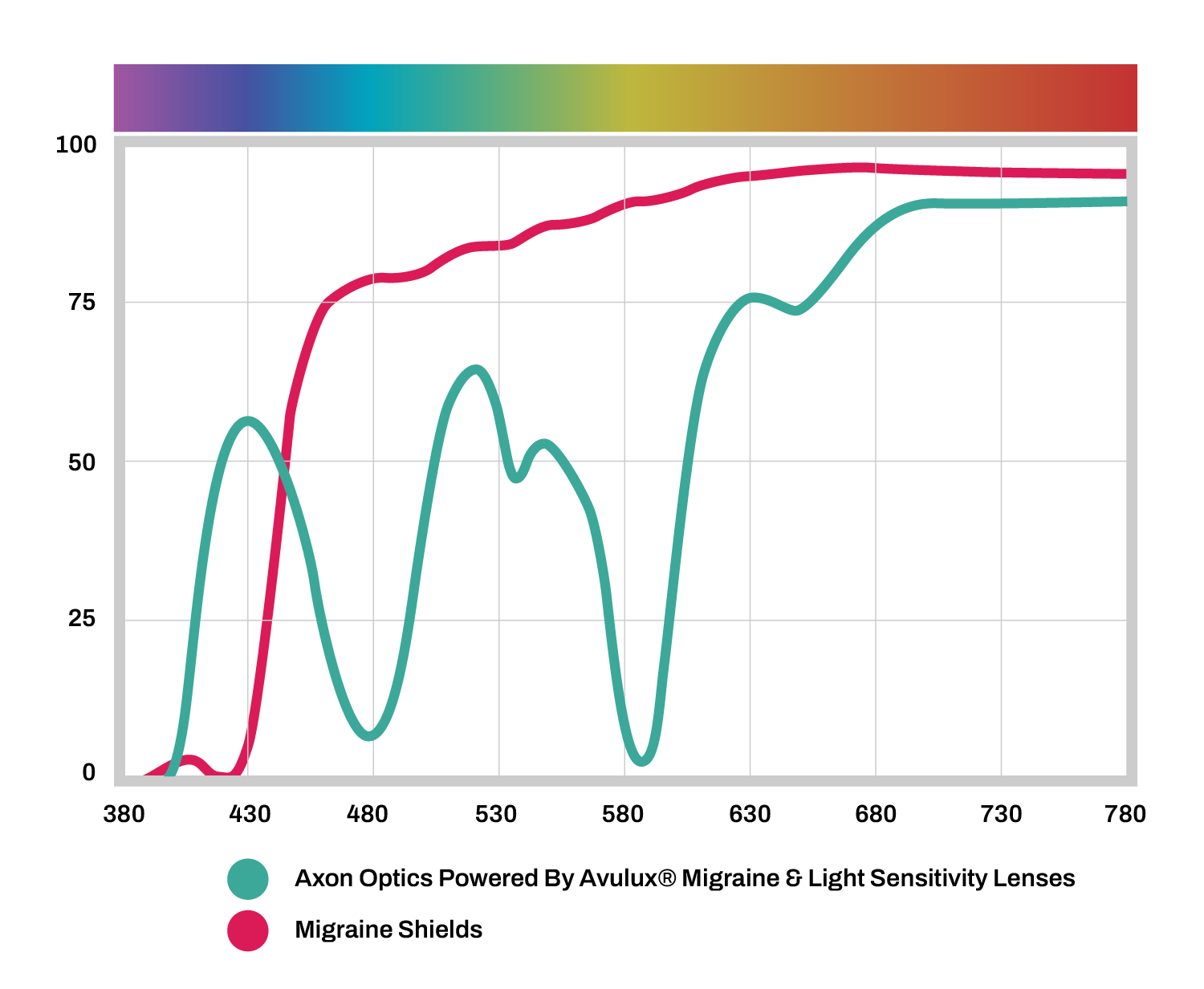
Migraine Shields
Axon Founder Publications on Light Sensitivity and Migraine
References
1. Vagge A, Ferro Desideri L, Del Noce C, Di Mola I, Sindaco D, Traverso CE. Blue light filtering ophthalmic lenses: A systematic review. Semin Ophthalmol. 2021;36(7):541-548. https://pubmed.ncbi.nlm.nih.gov/33734926/
2. Katz BJ, Digre KB. Diagnosis, pathophysiology, and treatment of photophobia. Surv Ophthalmol. 2016;61(4):466-477. https://pubmed.ncbi.nlm.nih.gov/26875996/
3. Hoggan, Ryan N, et al. “Thin-Film Optical Notch Filter Spectacle Coatings for the Treatment of Migraine and Photophobia.” Journal of Clinical Neuroscience : Official Journal of the Neurosurgical Society of Australasia, U.S. National Library of Medicine, June 2016, www.ncbi.nlm.nih.gov/pubmed/26935748
4. Lens spectrum measured on 08/02/21 on BPI Spectrometer. Charts below.




